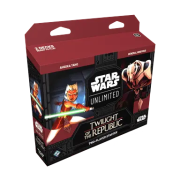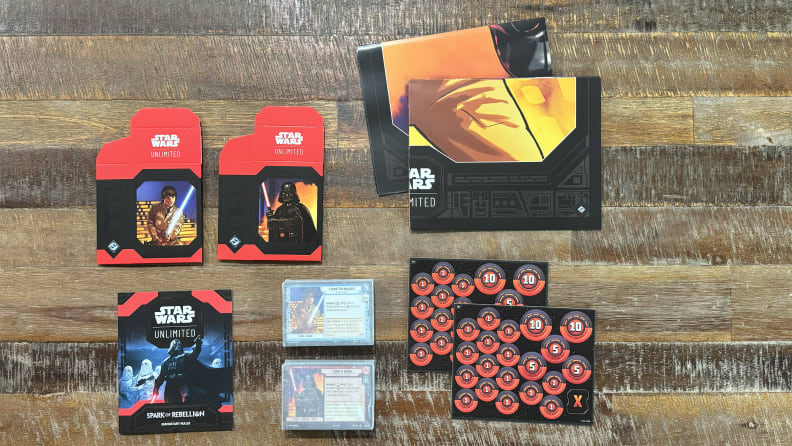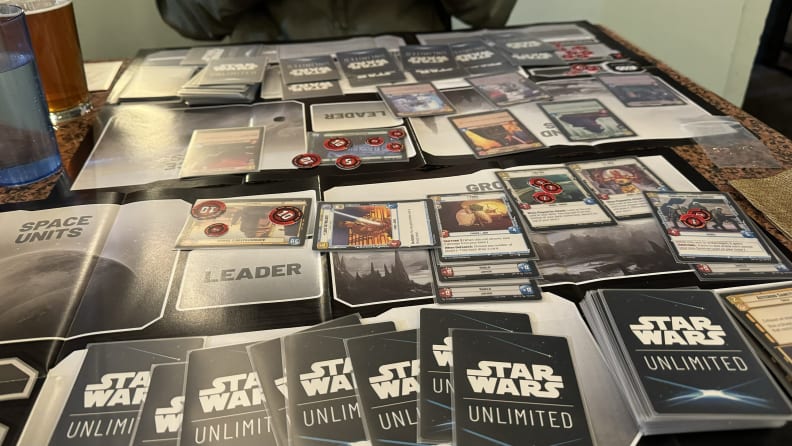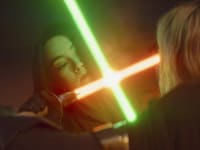Star Wars: Unlimited review
Fantasy Flight Games' latest Star Wars card game is a worthy TCG contender
 Credit:
Reviewed / John Higgins
Credit:
Reviewed / John Higgins
Products are chosen independently by our editors. Purchases made through our links may earn us a commission.
-

Star Wars Unlimited: Twilight of the Republic
Back in February, Asmodee (the parent company of Fantasy Flight Games) sent me the Star Wars: Unlimited Spark of Rebellion two-player starter kit—a new trading card game attempting to follow in the footsteps of the ever-popular Magic: the Gathering, among others. I was intrigued, having followed news about the game’s development throughout 2023 and being a life-long fan of the franchise. After playing the starter kit with some friends over the course of a week, I was optimistic. Gameplay was quick to pick up, the back-and-forth turn structure meant we were always staying engaged, and the pre-built decks were nicely balanced and accommodated different playstyles. The newest card set, titled Twilight of the Republic, is now available for preorder.
The card (and board) game space can be fickle and a bit saturated. A solid game doesn’t necessarily translate into a success. Since they acquired the license in 2011, Fantasy Flight Games (FFG) has produced some successful Star Wars-themed games—such as the asymmetrical two-player board game Rebellion and the miniature space battle game X-wing—as well as some that didn’t reach the same heights.
Star Wars: Unlimited fell into the former category, with demand far exceeding expectations. It required Fantasy Flight to adjust how they released its remaining stock of Spark of Rebellion (the first card set of the game) to players—making it available in waves as they ramped up production as best they could. Because of the lower stock out in the world, demand stayed at a high level and booster packs went fast as they made it to gaming stores, but at least there was enough product out to allow events to happen and keep game adopters engaged.
Since that impressive start, FFG has released a new card set every four months—the first, Shadows of the Galaxy, came out in July with Twilight of the Republic set to hit shelves on November 8. Each set has added a bunch of new cards and some new mechanics, keeping the strategy growing as the game matures. Now with three different two-player starter kits available, it’s a great time to get into Star Wars Unlimited.
What is Star Wars: Unlimited?

The two-person starter kit comes with everything you need to get playing.
Star Wars: Unlimited is a trading card game—think Magic: The Gathering but with droids and lightsabers—that was originally released on March 8, 2024. The first set at release was titled Spark of Rebellion, with the addition of Shadows of the Galaxy in July, and now Twilight of the Republic scheduled to be released on Nov 8. As with the previous releases, booster packs and a prerelease kit will be available to supplement the two-player starter kit. The Spark of Rebellion set focuses mainly on the original trilogy time period, although there are a few Galactic Republic (i.e. prequel) cards. Shadows of the Galaxy focused on the seedy underbelly of the Outer Rim, namely bounty hunters and smugglers, introducing the Bounty and Smuggle mechanics. Fans of Clone Wars will be pleased with the emphasis on the Galactic Republic and Separatists in Twilight of the Republic, and the addition of the Coordinate and Exploit mechanics—which activates with more units or allows you to defeat your own units to lower card costs, respectively—appropriately mirror tactics of those respective armies.
Players construct a deck of at least 50 cards and battle head-to-head with iconic characters and abilities to defeat their opponents’ base. The two-player starter kits come with everything you need to get started, including two complete decks. Alongside the decks are deck boxes to hold all the cards, fold-out playmats, a quickstart rules pamphlet, and a collection of indicator tokens used during play.
There have been Star Wars card games before, starting back with the Star Wars: Customizable Card Game in the ‘90s from Decipher, Inc. (of which I was a huge fan and a small, yet enthusiastic, fan base still exists). FFG have even released a few Star Wars single-box two-player games of varying complexity as well as some games that have since been discontinued—including Destiny, and the aforementioned Star Wars: The Card Game. The latter was a Living Card Game (LCG) that, instead of taking your chances opening randomized booster packs, released expansions with the same cards in every set.
How do you play Star Wars: Unlimited?

The layout might look similar to trading card game vets, but Star Wars: Unlimited still holds some interesting surprises.
Each player has a deck of at least 50 cards made of up units, events, and upgrades, in addition to one leader card and one base card. Players place their base and leader card in their horizontal orientations on the table. The initiative token is given randomly to one of the players, decks are shuffled, and players deal out starting hands of six cards. A player can choose to mulligan their starting hand, reshuffling all their cards together again and dealing out a fresh group of six. Players then choose two cards from their hand to place face down on the table. These cards become resources and are used to pay for cards during the course of play.
The game is broken down into rounds that consist of the Action phase and the Regroup phase. As opposed to other trading card games like Magic or Locana where each player takes the entirety of their turn before the next player goes, during the Action phase in Unlimited, players go back and forth completing one action at a time. Actions available to players are playing a card, attacking with a unit, using an action ability listed on a card, taking the initiative token (this can only be done once each round), or pass.
It’s a refreshing, different way to strategically plan, and helps to keep players involved, instead of sitting back and waiting potentially many minutes for other players to complete their turn.
Each card or ability is marked with its cost, paid for with the resources available on the table, and enters play exhausted (meaning it’s turned sideways and can’t be used during that round), unless stated otherwise on the card. An interesting mechanic in Unlimited is that the play area is divided into two arenas—ground and space—and units can only be played in their respective arenas, which is marked at the top of the card. Units (characters, starships, and vehicles) must attack enemy units within the same arena during combat.
Units have attack (power) and defense (HP) values on cards that determine how much damage they inflict and withstand, respectively. Damage is persistent across rounds, and when a unit’s HP reaches 0 it is defeated and placed in the player’s discard pile, along with any upgrades that might have been attached to it. Units can attack another unit or the opposing base to cause damage, which is marked with the included indicator tokens.
In addition to unit cards like Grand Moff Tarkin and Consular Security Force, there are events and upgrades. Events cards are played, resolved, and discarded—examples are Vanquish for five resources that instantly defeats a non-leader unit, or Repair that heals three damage from a unit or base. Upgrades attach to a unit to augment it in some way (often with more power or HP) and stay in play until the unit leaves play. Some, like Luke’s Lightsaber, add additional buffs when attached to a specific unit (in this case, unsurprisingly, the unit is Luke Skywalker).
Each player also has their leader card—for starter kits, the leaders are Luke Skywalker and Darth Vader (Spark of Rebellion), the Madalorian and Moff Gideon (Shadows of the Galaxy), or Ahsoka Tano and General Grievous (Twilight of the Republic)—with more available in booster packs. At the start of the game, these characters have Actions that can be taken during the Action Phase, as well as an Epic Action. When certain requirements (listed on each leader) are met, the Epic Action can be taken, allowing the card to be flipped over to its unit side, brought into the arena, and act as a powerful unit.
When defeated, the leader does not go into the player’s discard pile and is instead flipped back over, placed in its original position, and a token is used to mark that its Epic Action has been expended. You can only use a card’s Epic Action once in a game. The leader’s action can still be used as the game continues, though.
Once each player has used the Pass action consecutively, the Action Phase ends and the Regroup Phase begins, which just involves drawing two cards, choosing to play a card from your hand as a resource and readying all of your exhausted cards (moving them from being sideways to vertical). The next Action Phase then begins with whoever is in possession of the Initiative counter.
Play continues until the game’s objective has been reached—the destruction of your opponent’s base by bringing its HP to zero (the two bases in the starter kit have 30 HP).
It’s a fun, strategic game that continues to grow intelligently

Two new game mechanics in Twilight of the Republic are Exploit and Coordinate.
Star Wars: Unlimited has great replayability built in, as each shuffle and beginning hand is different. In general, the different starter decks are all balanced well and lean towards specific strategies. With the Spark of Rebellion starter decks, for instance, the Luke Skywalker deck focuses on deck management, healing, and shielding units while chipping away at your enemy while the Imperial deck is more about destructive power, buffing units, and using brute force to take down the Rebellion—although it can take some time to ramp up to the most powerful (and expensive) units. In the games I played against my friends, we found that the Luke Skywalker deck was more forgiving towards bad draws and came out on top more often than the Vader deck. But most games were closely matched, with both bases only a few points away from destruction.
While the starter kits contain everything that you need to play, the draw of trading card games is collecting new cards and adding them to your deck, or constructing brand new decks to play with. Spark of Rebellion contains a total of 252 cards, and both Shadows of teh Galaxy and Twilight of the Republic add 250 more each (the full collection can be found on the Star Wars: Unlimited website as well as a tool to virtually build decks).
Each booster pack comes with 16 cards—including one leader and one base—and nine common cards, three uncommon cards, and one rare or legendary card. The last card of the 16 is guaranteed to be a foil version (which has a glossy finish), and there’s a small chance of getting a Hyperspace variant with a different background, or a Showcase variant that features alternate art, a different frame, and the foil finish. (The Showcase cards are very rare, and even though I’ve sunk a decent amount of my own money into my collection, have yet to pull one.)
The deckbuilding part of the game has some interesting design to it. Unlike Magic, where decks are built around different types of land needed to call them into play, any card in Unlimited could feasibly be put into any deck, although potentially at a cost of extra resources.
The leader and base cards are marked with Aspect Icons, two on each leader and one on each base, giving your deck three Aspect Icons. There are a total of six different aspects in the game—vigilance, aggression, heroism, command, cunning, and villainy—and every card, except for two in the Spark of Rebellion set, are marked with one or two different Aspects. There are a handful of cards that double up on one Aspect (the Rallying Cry card has two aggression Aspects, for instance).
As mentioned, any card can be in any deck, but if the card has an Aspect that isn’t on your leader and base cards, you have to pay a resource penalty to play it. That penalty is two extra resources beyond the card’s cost for each Aspect not a part of your deck. So if your deck consisted of vigilance, aggression, and cunning Aspects, that Rallying Cry card would still cost an extra two resources to play since it has two aggression.
Depending on your location, there’s a good community of players with some robust organized play support from FFG. Booster packs were designed to support both sealed and draft formats if your local friendly game store offers play nights. Stores can also order play kits from FFG for in-store events. There’s the Weekly Play kit that supports play across eight weeks or Store Showdown kits for a 32-player brawl.
Accessories to enhance the experience

The focus of Twilight of the Republic are on Galactic Republic and Separatist cards.
The game also comes to market with some extra official accessories available from Gamegenic, another Asmodee Group company like FFG. There are a variety of card sleeves with different characters on them including all of the starter deck characters. One thoughtful design detail of the Two Player Starter Kit is that the included foldable deck boxes that are sized to fit sleeved cards.
Gamegenic has Star Wars: Unlimited branded deck boxes (they call them Deck Pods) that have clear windows where you can put your leader card so each deck can quickly be identified from the outside. The Deck Pods fold open to reveal storage for up to 60 double-sleeved cards and a drawer to keep tokens and other accessories. There’s also a Double Deck Pod that holds two decks (up to 60 double-sleeved cards for each), two drawers for tokens, and two leader card slots on the outside. Both versions come in yellow, red, blue, green, black, and white/black.
Rounding out accessories are premium acrylic tokens to replace the cardboard ones that come with the starter kit, game mats with Unlimited artwork, and a couple include zones marked off for where to put your cards during play to keep you organized. If you’re planning on playing regularly, playmats are a huge benefit (and the artwork on them is fantastic). They keep the cards from sliding around the table (especially if you have them sleeved) and the cushion they provide makes it infinitely easier to pick them up.
While the included foldable playmats are great to get you started with rules reminders and guide you on how to organize your play space, the placement area for some spaces either weren’t large enough (especially the ground arena) or caused me to forget about them (the Initiative counter is off to the left out of my periphery). Plus, I was constantly frustrated trying to pick up my sleeved cards while playing.
It’s a blast for Star Wars fans interested in card games

Star Wars: Unlimited is an solid entry into the trading card game space.
I’ve been in and out of trading card games for years, having spent many hours with the Star Wars: Collectible Card Game, a few stints in Magic (I still occasionally play my Tiamat deck from the Forgotten Realms set), and most recently a foray into Lorcana. Star Wars: Unlimited is now my go-to choice for a TCG. The learning curve to get in is completely accessible, but there’s still the ability to get down and dirty with deck building now that we’re going into our third set of cards.
With the variety of well-balanced starter decks now available that cater to different playstyles and Star Wars time periods, it’s a great way to get started in the world of trading card games.



